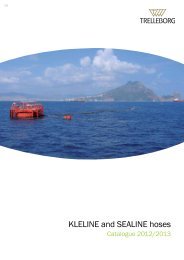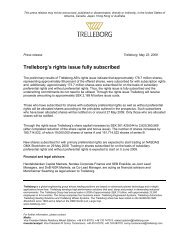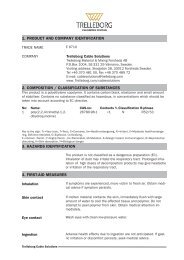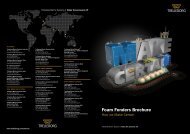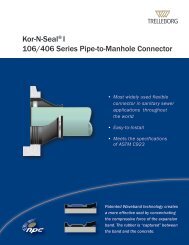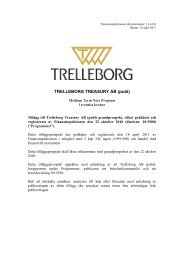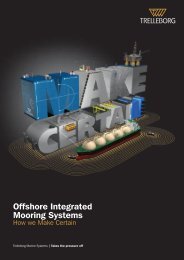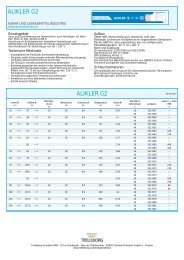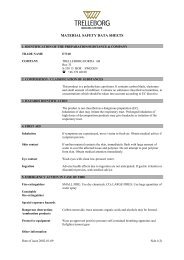Annual report 2011 - Trelleborg
Annual report 2011 - Trelleborg
Annual report 2011 - Trelleborg
You also want an ePaper? Increase the reach of your titles
YUMPU automatically turns print PDFs into web optimized ePapers that Google loves.
loss. If the loan, and consequently, future interest payments, ceases to exist,<br />
the accumulated gain or loss recognized in equity is transferred immediately to<br />
profit and loss.<br />
Hedging of net investments in foreign subsidiaries<br />
The Group has borrowings, foreign-exchange forward contracts and currency<br />
options in foreign currencies to hedge investments in foreign subsidiaries.<br />
These borrowings and contracts are measured at the closing rate. In the consolidated<br />
balance sheet, the borrowings are measured at the closing rate and<br />
exchange-rate differences are recognized directly against equity, after adjustment<br />
for the tax portion.<br />
The Group has borrowings in foreign currency with certain subsidiaries<br />
where the loans represent a permanent part of the Parent Company’s financing<br />
of the subsidiary. These loans are hedged for foreign-exchange risks in the<br />
same way as investments in foreign subsidiaries are hedged. Loans and hedges<br />
are recognized at the closing rate, with exchange-rate differences on these<br />
loans and hedges being recognized directly in equity. Any ineffective portion of<br />
the exchange-rate difference is recognized directly in profit and loss as a financial<br />
item.<br />
Accumulated gains and losses in equity are recognized in profit and loss<br />
when the foreign operations are disposed of.<br />
Realized exchange-rate differences on borrowings and forward contracts are<br />
recognized in the cash-flow statement under “Financing activities”.<br />
Inventories<br />
Inventories are measured at the lower of cost and net realizable value on the<br />
closing date. Cost is calculated according to the first-in/first-out (FIFO) principle.<br />
For finished products and work in progress, cost consists of raw materials,<br />
direct personnel costs, other direct costs and related indirect production costs.<br />
Normal capacity utilization is used in the measurement of inventories. Borrowing<br />
costs are not included. The net realizable value is calculated as the estimated<br />
selling price less applicable variable sales expenses. Deductions are made for<br />
internal profits generated through intra-Group sales.<br />
Equity<br />
Costs arising in connection with new share issues and the repurchase of<br />
treasury shares are recognized directly in equity.<br />
The redemption of convertibles and the exercise of share warrants entail<br />
new shares being issued while the exercise of call options may entail the utilization<br />
of treasury shares.<br />
The proceeds from the sale of treasury shares are recognized directly in<br />
equity. Holdings of treasury shares reduce profit brought forward. When treasury<br />
shares are cancelled, the share capital is reduced by an amount corresponding<br />
to the par value of the shares and accumulated profit or loss is increased by the<br />
corresponding amount.<br />
Provisions<br />
Provisions are recognized when the Group has a legal or constructive obligation<br />
resulting from past events and it is probable that payment will be required to<br />
meet the obligation, and that the amount can be calculated in a reliable manner.<br />
The provision for restructuring primarily covers costs relating to severance pay<br />
and other costs affecting cash flow arising in conjunction with restructuring the<br />
Group’s operations.<br />
Provisions are established when a detailed, formal plan for measures to be<br />
undertaken has been established and valid expectations have been raised by<br />
those who will be affected by such measures. No provisions are made for future<br />
operating losses. Provisions are made for environmental activities related to<br />
earlier operations when it is probable that a payment liability will arise and when<br />
the amount can be estimated with reasonable precision. Provisions are divided<br />
into non-current and current provisions.<br />
Shareholders’ contributions and Group contributions<br />
Shareholders’ contributions to subsidiaries are added to the value of shares<br />
and participations in the balance sheet, after which, impairment testing is<br />
conducted.<br />
Group contributions are provided to minimize the Group’s tax expenses.<br />
Group contributions made from the Parent Company to a subsidiary are recognized<br />
in profit and loss in the item Income from participations in Group companies.<br />
Group contributions that the Parent Company receives from subsidiaries<br />
are recognized in the Parent Company in the item Income from participations in<br />
Group companies. Tax on Group contributions is recognized in profit and loss.<br />
Subsidiaries recognize Group contributions against shareholders’ equity after<br />
adjustments for tax.<br />
Government grants<br />
Government grants are recognized at fair value when it is probable that the<br />
terms associated with the grants will be met and that the grants will be<br />
received. Government grants relating to the acquisition of assets reduces the<br />
cost of the assets. Government grants providing compensation for expenses are<br />
recognized systematically over the same period as the expenses to be offset.<br />
NOTES – GROUP<br />
Employee benefits<br />
Pension obligations<br />
Within the Group, there are a number of defined-contribution pension plans and<br />
defined-benefit pension plans, of which a small number have plan assets in<br />
foundations or similar.<br />
A defined-contribution pension plan is a plan in which the Group pays fixed<br />
fees to a separate legal entity. The Group does not have any legal or informal<br />
obligations to pay additional contributions if this legal entity has insufficient<br />
assets with which to make all pension payments to employees that are associated<br />
with the current or past service of employees. In a defined-benefit pension<br />
plan, the amount of the pension benefit an employee will receive after retirement<br />
is based on factors such as age, period of service and salary.<br />
Pension plans are normally financed through contributions to a separate<br />
legal entity from each Group company and from the employees.<br />
The liability recognized in the balance sheet in respect of defined-benefit<br />
pension plans is the present value of the defined-benefit obligation on the<br />
closing date, less the fair value of plan assets and is adjusted for unrecognized<br />
actuarial gains and losses and unrecognized expenses for past service.<br />
For defined-benefit plans, the liability is calculated using the Projected Unit<br />
Credit Method, which allocates the cost over the employee’s working life. The<br />
calculations are undertaken by actuaries, who also annually reassess the value<br />
of the pension obligations. These assumptions are based on the present value<br />
of future pension payments and are calculated using a discount rate corresponding<br />
to the interest on first-class corporate bonds or government bonds<br />
with a remaining maturity largely matching that of the current pension obligations.<br />
For funded pension plans, the fair value of plan assets reduces the calculated<br />
pension obligation. Funded plans with net assets, i.e. where the assets<br />
exceed the obligations, are recognized as plan assets. If accumulated actuarial<br />
gains and losses arising from experience-based adjustments and changes to<br />
actuarial assumptions exceed the higher of 10 percent of the pension obligations,<br />
or the market value of the plan assets, the excess amount is recognized<br />
over the expected average remaining working life of the employees participating<br />
in the plan. Some of the ITP plans in Sweden are financed through insurance<br />
premiums paid to Alecta. This is a defined-benefit plan and encompasses<br />
several employers. As <strong>Trelleborg</strong> did not have access to information to enable it<br />
to recognize this plan as a defined-benefit plan, it was, consequently, recognized<br />
as a defined-contribution plan.<br />
The Group’s pension payments for defined-contribution plans are expensed<br />
in all functions in profit and loss in the period in which the employees carried<br />
out the service to which the contribution refers. Prepaid contributions are recognized<br />
as an asset insofar as cash repayments or reductions of future payments<br />
can benefit the Group.<br />
Other post-employment benefits<br />
Certain Group companies, primarily in the US, provide post-retirement medical<br />
care benefits for their employees. Entitlement to these benefits normally<br />
requires that the employee remains in service until retirement and works for the<br />
company for a specific number of years. The anticipated cost of these benefits<br />
is recognized over the period of service through the application of an accounting<br />
method similar to that used for defined-benefit pension plans. Actuarial gains<br />
and losses are recognized over the expected average remaining working life of<br />
the employees concerned. These obligations are assessed by qualified actuaries.<br />
Variable salaries<br />
Provisions for variable salaries are expensed on an ongoing basis in accordance<br />
with the financial implications of the agreement.<br />
Remuneration on termination<br />
Remuneration is normally payable if employment is terminated prior to normal<br />
retirement age, or when an employee accepts voluntary termination in exchange<br />
for remuneration. The Group recognizes severance pay when a detailed formal<br />
plan has been presented.<br />
Related-party transactions<br />
The Group’s transactions with related parties pertain to purchases and sales to<br />
associated companies, which for the Group represented insignificant amounts.<br />
All transactions are priced in accordance with market terms and prices. In addition,<br />
compensation is paid to the Board of Directors and senior executives; refer<br />
to Note 3 for further information.<br />
Critical accounting estimates and judgments<br />
Company management and the Board of Directors make estimates and assumptions<br />
about the future. These estimates and assumptions impact recognized<br />
assets and liabilities, as well as revenue and expenses and other disclosures,<br />
including contingent liabilities. These estimates are based on historical experience<br />
and on various assumptions considered reasonable under the prevailing<br />
conditions. The conclusions reached in this manner form the basis for decisions<br />
concerning the carrying amounts of assets and liabilities where these cannot be<br />
determined by means of other information. The actual outcome may diverge<br />
from these estimates if other assumptions are made, or other conditions arise.<br />
GRI: EC3 <strong>Annual</strong> Report <strong>2011</strong> <strong>Trelleborg</strong> AB 79




